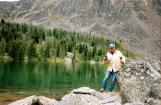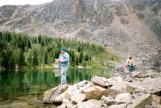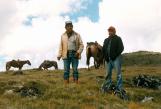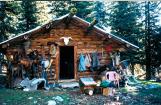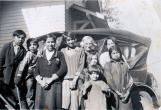27
Farming and RanchingWild horses were moved from Palmer Lake through the valley to Princeton. Horses were taken to Oliver for grazing. The Similkameen people providedorses for World War I and World War II. At the peak of the horse runs there were approximately 1500 head in the Similkameen Valley. At this time, Similkameen people were consumers of horse meat.
The Similkameen people were well known fo rtheir outstanding quality of horses and horsemanship. In the past, Similkameen people were the supplier of horses to the Russian army. The 1960's saw the destruction of the Horse herds as there came to be a bounty out for the horses. As the valley was settled, there came to be a perceived over abudance of horses.
As communities were further agriculturally developed, they incorporated cattle ranching as a way of life. There were many successful ranches that existed within the community. Some of these included:
Early Farmers and Ranchers Yakumticum, Showdy Ranch, Narcisse, Billy Francois, Shorty Michelle, Jimmy Robinson. Indian Edward, Qualtier Ranch, Allison Brothers, Showdy Creek Ranch, Harry Robinson, Abraham Louie, Hans Richter, Willie Terbasket, Eneas Nehumpchin, Paul Terbasket, Alex Skius, Joe Dennis, Johnny Chuchuwasket, Harry and George McGinnis, Pierre John Ranch, Johnnie Holmes, Charlie Allison, Wici Allison, Harry Squakin, Pinto Jack.
Current ranches include. Qualtier Ranch, Allison Ranch, Louie Ranch, Gottfriedson Ranch, Blind Creek Ranch, Henry Dennis Ranch, Robert Dennis Ranch, Turtle Creek Ranch, Ralph Bent Ranch,
28
Hedley Butcher/Slaughterhouse Johnny Holmes (riding) Jack Cohen (branding iron) other man (unknown)1940
Hedley BC, Canada
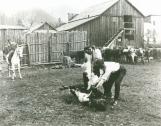 Credits:
Credits:Enowkin Centre
29
Wheat Harvest at what is now Blind Creek Ranch above Cawston BC1953
Blind Creek, Cawston BC, Canada
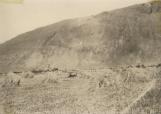 Credits:
Credits:Lower Similkameen Indian Band
30
Trading within CommunityIt is a well known fact that at the time of the depression, Similkameen people assisted the off reserve community by providing employment on the established Indian ranches. They also provided a good supply of food from the gardens and fruit trees. They would also travel by train to Keremeos to trade crafted buckskin items for dried goods at the Ben Williams store and at the Grist Mill for flour.
Internally within the community, the people had a trade system that provided for communities within families. ie. Farmers would trade other families for butter and eggs in turn for fruit and vegetables and meats.
31
Louie Pierre riding a rake at the Charlie Allison Ranch1950's
Hedley BC, Canada
 Credits:
Credits:Lower Similkameen Indian Band
36
(l to r) Nora Allison Yakumtikum (xil xatkw) and Maggie Terbasket1925
Chopaka BC Canada
 Credits:
Credits:Enowkin Centre, Penticton BC
37
Similkameen TerritoryThe lands of the Similkameen included the valleys from the Skagit to Christina Lake and from Vernon to Brewster.
The lands of the Similkameen people included areas that were expropraited by the Federal Government to provide for the Veterans that returned from the war. These lands were taken without consultation of the Similkameen people.
To date there remains existing Specific Land Claims that will at some point be addressed between the Federal and Provincial Governments and the Indigenous peoples of the nation and the community.
When reserves were established, the lands set aside for the Similkameen People were;
IR#1 the entirety of Cawston Flats
IR#2 Similkameen
IR#3 Kilpoola
IR#4 Narcisse's Farm
IR #5 from Upper Cawston Flats through including Rocking Chair Ranch
IR Keremeos Creek the flat of Bear Frasch's through to Sportsman's Corner (originally a village site)
IR#6 Blind Creek
IR#7 Chopaka North
IR#8 Chopaka South
IR#9 Alexis
IR#10 Ashnola
IR#11 John's Creek
IR#12/12 A Keremeos Forks
IR#13 Range lands
38
Nehumpchin family children (l to r) Katherine, Maggie and Mose Nehumpchin1917
Oroville Washington
 Credits:
Credits:Lower Similkameen Indian Band
39
EducationThe students rode on horseback to a small school house located near the United States border. The school was a 14' x 20' Log and Sod schoolhouse. The second schoolhouse was stick built and was located further south of the original location but was placed on the creekside. The second schoolhouse held approximately 30 students. Of the 30 students 1/3 were native students, 1/3 were local students and 1/3 were students of workers from the mines.
As with all Native peoples, the Government made it mandatory that Indian children attend Residential schools. The children were picked up by cattle truck and sent originally to the Residential school in Cranbrook. Upon closure of the Cranbrook school the children were sent to Kamloops Residental School. The Mormon recruiters came into the Similkameen Valley to pick up children for conversion to their faith and for attendence to school. Parents of the children caught up to the group in the United States and brought the children back home. Many of the Similkameen children also attended the Mission School at Omak Washington.
Following closure of the Cranbrook Residential school, students attended the public school that is now Cawston Hall. Later the Cawston School was constructed and then further renovated to its current state.
